Archive for the 'Content Type' Category
Posted by James (admin) on 14th April 2014
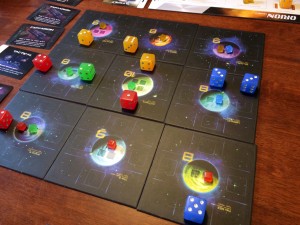
Quantum is a light, space-themed game. Players have ships which are represented by dice that travel between the planets trying to colonise them (place cubes on them). The first player to place all their cubes wins.
The ships (dice) are rolled to determine what type of ship they are – a low number means they are slow moving but powerful in combat, and vice versa. (In fact, the dice value is how many spaces they can move which makes things simple.) Each type of ship has a special power too, such as transporting another ship, swapping places, changing a ship’s value and this makes each quite different.
On their turn, a player can take 3 actions. An action can be used to activate a ship (move/attack), re-roll a ship, bring a ship on from the scrap yard, or carry out research. A player can use 2 actions to place a cube on a planet if they have ships next to the planet that add up to the planet’s number and if there is still room to place a cube there. (A player can also place a cube if they win enough combats.) Read the rest of this entry »
Tags: board game news, Board Games, board gaming, Essen, Funforge, Quantum, Spiel 13, Spiel 2013
Posted in Board Game Review, Board Games, Essen Spiel 13, Quantum, Spiel 2013 | No Comments »
Posted by James (admin) on 11th April 2014
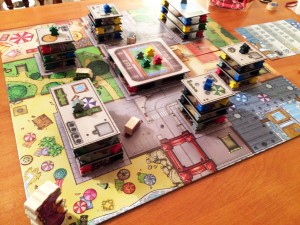 Rampage is a brilliant concept for a dexterity game. It’s like a Godzilla-style movie with tall buildings to destroy and people to eat. The board is divided into several coloured areas called neighbourhoods, and the player with the most Victory Points (VPs) at game end wins.
Rampage is a brilliant concept for a dexterity game. It’s like a Godzilla-style movie with tall buildings to destroy and people to eat. The board is divided into several coloured areas called neighbourhoods, and the player with the most Victory Points (VPs) at game end wins.
Rampage may sound kind of normal so far for a board game but it is anything but that as the gameplay is actually based on physically destroying the city. Each turn, your monster get 2 actions. To move your monster, you flick the feet disc. To attack buildings, take your monster piece and drop it onto a building (if you’re near enough). To use your breathe attack, place your chin on your monster piece and blow. To throw a vehicle, place the vehicle piece on top of your monster and flick it. Monsters can attack anything including each other and a successful attack removes one of their teeth. After their actions, your monster eats meeple out in the open in their current neighbourhood but no more than the number of teeth they have.
Buildings consist of layers of card floors separated by meeple of random colours. You want to knock these buildings down so you can (potentially) eat the meeple but you also take any floor sections which have nothing on them as these are worth VPs too. Read the rest of this entry »
Tags: board game news, Board Games, board gaming, Essen, Rampage, Repos Productions, Spiel 13, Spiel 2013
Posted in Board Game Review, Board Games, Essen Spiel 13, Rampage, Spiel 2013 | No Comments »
Posted by James (admin) on 10th April 2014
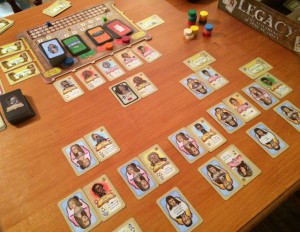
Legacy (or Legacy: Testament of Duke de Crecy to give it its full name) is a very innovative game where players try to create the most successful 18th century family starting with a single family member. Each round, players use their actions so that the current generation can get married, have children, buy mansions, start business ventures, arrange marriages for their children, etc. After a fixed number of rounds, the children grow up, any arranged marriages take place, and they become the current generation. Players then use actions for this new generation to get married, have children, etc. After the 3rd generation’s actions, the game ends and the player with the most points (Honour) wins.
Each player has an income track which earns cash each round, and a prestige track which earns Honour each generation. Players also earn Honour for having children, fulfilling objectives on their Patron card, fulfilling missions, as well as from friends marrying into the family, acquiring titles, etc. Plus, players must constantly manage their cash and friends – Friends are cards in a player’s hand each showing their sex, nationality, occupation, benefit when married into your family, and marriage cost (some generate cash as they come with a dowry). Read the rest of this entry »
Tags: board game news, Board Games, board gaming, Essen, Legacy, Portal Publishing, Spiel 13, Spiel 2013
Posted in Board Game Review, Board Games, Essen Spiel 13, Legacy, Spiel 2013 | 4 Comments »
Posted by James (admin) on 9th April 2014
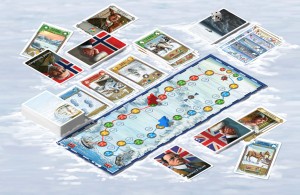 1911 Amundsen vs Scott is a simple, quick-moving, 2-player race to the South Pole which is full of small decisions. The game is based on the real events where Amundsen beat Scott to the Pole and Scott didn’t return.
1911 Amundsen vs Scott is a simple, quick-moving, 2-player race to the South Pole which is full of small decisions. The game is based on the real events where Amundsen beat Scott to the Pole and Scott didn’t return.
Players each have their own path of coloured spaces to move along and the first player to reach the South Pole wins. On their turn, a player draws 1-3 cards and can then play cards. When taking cards, you must draw the right-most (oldest) 1, 2 or 3 cards by discarding 0, 1 or 3 cards from your hand respectively. This can make for some interesting decisions because if you see cards you really want (or ones you don’t to deny your opponent) then you must decide whether it’s worth discarding cards you have to gain the new ones.
Almost all cards show one of 4 colours and many cards show one of the various special actions too (occurring when drawn, played or discarded). To move, you must play cards that match the colours of the next spaces along your path – 1 card for your next space, 2 cards for each space after that. This adds lots of fast card-management decisions to your game as you’re constantly trying to collect the mix of cards that will advance you and hinder your opponent. Many cards are both a colour and a type which adds some extra decisions to work out whether to use a card for its colour or its type (special effect). This is made slightly more tricky because you have a hand limit of 7 cards (and sometimes even fewer), plus the mix of cards you want changes rapidly as you and your opponent move. Read the rest of this entry »
Tags: 1911 Amundsen vs Scott, board game news, Board Games, board gaming, Essen, Spiel 13, Spiel 2013
Posted in 1911 Amundsen vs Scott, Board Game Review, Board Games, Essen Spiel 13, Spiel 2013 | No Comments »
Posted by James (admin) on 8th April 2014
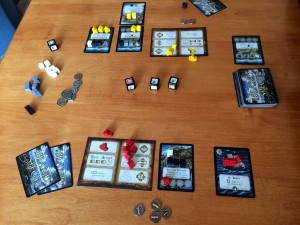 Island Siege caught my interest when it was a Kickstarter project but I only picked it up recently. A game for 2-players, it’s a card game at heart but feels bigger because the cards played stay on the table (well, until they’re blown to smithereens) and there are some very nice metal coins, a few wooden meeple and some dice too.
Island Siege caught my interest when it was a Kickstarter project but I only picked it up recently. A game for 2-players, it’s a card game at heart but feels bigger because the cards played stay on the table (well, until they’re blown to smithereens) and there are some very nice metal coins, a few wooden meeple and some dice too.
A player wins at the very start of their turn if all of the colonists on their Imperial card have been placed elsewhere or if they have 20+ coins. Each player starts with a fortress, a few cards in hand, and 9 colonists (meeple) on their Imperial card. Each turn, a player moves 1 colonist from their Imperial card onto each of their fortresses and then either:
- Draws 3 cards, keeping 2 and giving the other to their opponent
- Pays the relevant cost to build a card (fortress, ship or building) from their hand
- Attacks one of their opponent’s fortresses
Fortresses can be built for free, but adding extra building blocks (black/grey/white cubes) from your supply makes them stronger and earns coins. Buildings and ships can be built by moving enough colonists from a single fortress card to the building/ship card and this also earn coins. Buildings are added to a fortress giving it special abilities, but buildings are lost if the fortress they’re attached to is destroyed. Ships are independent, have special abilities and can also be destroyed.
Read the rest of this entry »
Tags: Ape Games, board game news, Board Games, board gaming, Island Siege
Posted in Board Game Review, Board Games, Island Siege | No Comments »
Posted by James (admin) on 4th April 2014
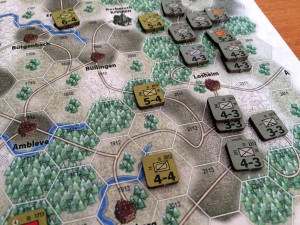 ‘Paul Koenig’s The Bulge: 6th Panzer Army’ (to use its full name) is a tactical, 2-player, World War II game with a hex map and counters. However, it packs a massive amount of decision-making into such a small area, and with relatively simple rules.
‘Paul Koenig’s The Bulge: 6th Panzer Army’ (to use its full name) is a tactical, 2-player, World War II game with a hex map and counters. However, it packs a massive amount of decision-making into such a small area, and with relatively simple rules.
One player plays the German army trying to break through the Allied lines by a surprise advance through the Ardennes forest (an event of major importance during the war), and the other player plays the Allies. This means the two sides are quite different – the Germans have lots of units but also have a lot of work to do as they need to advance to capture cities and get across the map; whereas, the Allied player has few units and needs to use these to hold up and disrupt the German advance.
The game ends after 7 turns when victory points (VPs) are assessed. The Germans score VPs for capturing cities and getting mechanised units (tanks, etc.) across to the far side of the map or, even better, beyond it. The Allies score VPs for cities not captured by the Germans. In addition, both sides score VPs for destroying units although the Allies score more for them, which balances up the other VPs the Germans can earn. When the game is over, the Allies win of they have at least 6 VPs more than the Germans (the Allies start with lots of VPs because no cities have been captured by the Germans yet). Read the rest of this entry »
Tags: 6th Panzer Army, Paul Koenig, Victory Point Games, VPG, WWII
Posted in 6th Panzer Army, Board Game Review, Board Games | 6 Comments »
Posted by James (admin) on 7th February 2014
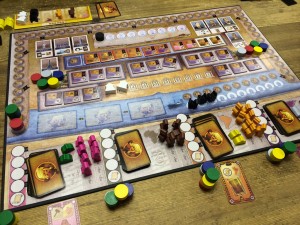 Artifact is a worker placement game with a difference as players place a common set of action markers which are limited in number and the cost of using them varies.
Artifact is a worker placement game with a difference as players place a common set of action markers which are limited in number and the cost of using them varies.
THE GAME
Players are archaeologists digging up artifacts, shipping them home and putting on exhibitions (after all, as Indy taught us, ‘they belong in a museum’). Players primarily score victory points (VPs) at game end by gaining museum exhibition tiles and having cash. The final round is triggered by one of 4 different events such as finishing the 8th round, when one deck of artifact cards runs out, etc.
Actions
During a round, players take turns performing either 1 or 2 actions. If a player passes, they can not perform any more normal actions that round (although they can perform a special action on their turn). All players start each round with 6 wooden action markers and there are 6 different types of these: ships, museums and 4 different colours of workers (one for each continent). The board has a track for each type of action marker and each space on these tracks shows a cost (going from from 5 down 1). Read the rest of this entry »
Tags: Artifact, Bernd Eisenstein, board game news, Board Games, board gaming, Essen, Jeffrey D Allers, Spiel 13, Spiel 2013, White Goblin Games
Posted in Artifact, Board Game Review, Board Games, Essen Spiel 13, Spiel 2013 | No Comments »
Posted by James (admin) on 6th February 2014
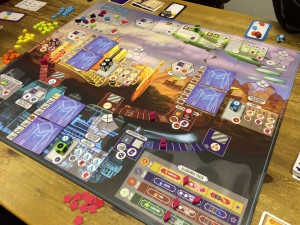 After playing Euphoria as a 2-player game, I thought I would post some more detailed thoughts about it as there seems to be a fair amount of interest in how it plays with two. This is really a post for those whom know how Euphoria is played as it goes into detail about the rules and assumes knowledge of them. (To find out more about Euphoria, you can read my main review.)
After playing Euphoria as a 2-player game, I thought I would post some more detailed thoughts about it as there seems to be a fair amount of interest in how it plays with two. This is really a post for those whom know how Euphoria is played as it goes into detail about the rules and assumes knowledge of them. (To find out more about Euphoria, you can read my main review.)
PLAYING WITH 2 PLAYERS
When played with 2 players, Euphoria is played almost the same way as with more players with just 2 rules differences: First, there are only spaces for 2 stars in each territory. Second, it takes only 2 actions to build each market which means markets are built very quickly and we soon had all 6 complete. We both built markets that we knew our opponent could not assist in before they were completed. As a result, we were both soon playing with 3 restrictions each (although I paid one off later). I didn’t mind this at all as it made for some interesting choices and gave us both a different perspective of the board.
As with 5 players, I enjoyed playing Euphoria with 2 players – the theme works really well with the game mechanics and I like the constant decisions involved; however, I did find it gave a slightly different experience compared to when played with more players. The key reason for this is that some of the game mechanics feel a bit more subdued than when played with more players, such as the development of the allegiance and tunnel tracks which add an interesting element to the game. Also, with fewer players there is less chance of your workers being bounced back to you and less chance of higher totals when earning commodities. I’ll discuss these items in more detail below along with some suggestions as to how I think a few rules changes may address these. Read the rest of this entry »
Tags: Board Games, board gaming, Euphoria
Posted in Board Games, Thoughts On | 1 Comment »
Posted by James (admin) on 30th January 2014
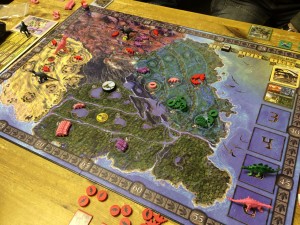 Triassic Terror is a dinosaur-themed, area control game by Peter Hawes – designer of Francis Drake (I will be reviewing this soon), Wars of the Roses and Heads of State.
Triassic Terror is a dinosaur-themed, area control game by Peter Hawes – designer of Francis Drake (I will be reviewing this soon), Wars of the Roses and Heads of State.
THE GAME
During the game, players try to dominate the landscape by growing their dinosaur herds and moving them from area to area. The board is split into 4 different terrains which are each split into 3 areas. There are 3 positions within each area – the largest herd in an area takes the best position, second largest takes the next one, and third largest takes the last one. If there’s a fourth herd in an area, it immediately dies – welcome to the harsh brutality of Triassic Terror.
The game lasts several rounds and Victory Points (VPs) are scored after each era (a group of rounds). VPs are scored based the on position a herd occupies in an area – each area scores slightly differently but the most VPs are always for the better positions (occupied by the biggest herd in the area). One side of the board is for 2-4 players, the other for 5-6 players – the difference being that the numbers of VPs scored are slightly different and all 3 positions in each area score in the 5-6 player game (rather than just the top two). Read the rest of this entry »
Tags: board game news, Board Games, board gaming, Essen, Spiel 13, Spiel 2013, Triassic Terror
Posted in Board Game Review, Board Games, Essen Spiel 13, Spiel 2013, Triassic Terror | No Comments »
Posted by James (admin) on 29th January 2014
 Played: Euphoria Played: Euphoria
After playing Euphoria last week with 5 players, a couple of us wanted to try it with 2 players. The game is mostly the same with just 2 differences: it takes only 2 actions to build a market (not 4 when played with 5 players), and there are only 2 spaces where stars can be placed in each territory (not 5 as with 5 players).
As before, I enjoyed playing Euphoria – the theme works really well with the game mechanics and working out how to use workers and resources is entertaining. It worked fine with 2 players, although I think it’s more fun with more players as there’s more chance of your workers being bounced back to you, more chance of higher totals to earn commodities, and more development of the allegiance tracks and mines which make a big difference.
I think most of the issues could be solved with a few more rules for scaling the game, such as making the tracks shorter. I’ll post more thoughts about this soon.
Euphoria worked well enough with 2 players – I would prefer to play it with more but, with the current rules, I think 3 players would be fine and 4+ would be best.
Played with 2. (To find out more about Euphoria, you can read my main review.) |
|
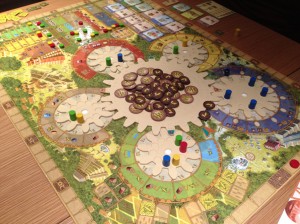 Played: Tzolk’in Played: Tzolk’in
It had been a long time since I last played Tzolk’in and it definitely showed as I tried to recall my previous games so I could create a decent flow of resources to then convert into points.
Tzolk’in is definitely a tricky game to balance which makes it a good challenge. There are several ways to score points and I think you definitely need to choose to pursue just one or two of these in order to do well.
Tzolk’in works well with 2 players. Each 2-player game can be a little different as neutral workers block some of the locations on the wheels (determined by randomly drawn cards at the start of the game). I think the 2-player game may be slightly more forgiving as turn order can be quite brutal with more players because the last player in turn order can find the wheels packed with workers – whilst that means they could place their workers further around a wheel, it requires lots of corn.
Played with 2. (For more details on Tzolk’in, you can read my full review.) |
|
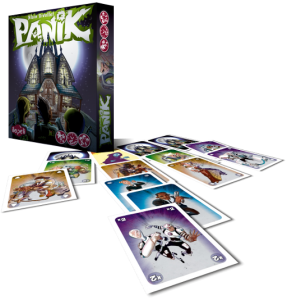 Played: Panik Played: Panik
Panik is a very quick, light game with some bluffing. Players place their ghost hunters in front of mansions in order to score points equal to the mansion’s value; however, each player only knows what a few of the mansions are worth (and each player knows about different mansions). Placing a ghost hunter can expel one already placed there to a different mansion (chosen by the expelled card’s owner) so there’s some jostling during the game. Various ghost hunters have special effects too.
With limited information on which to base to your decisions, the fun is from trying to read into what your opponent(s) have done. However, that also means you need to work out if they’re trying to mislead you, and work out how you can mislead them too.
Panik worked quite well with 2 players (taking only 5-10 minutes for a game); however, I think it’s better with more. The mind games and displacing other ghost hunters mean there’s more to it than it first appears, but there may not be too much more to discover after some replay. Can work as a gamers’ filler game, but more for a lighter audience.
Played with 2 and 4. |
James.
Tags: board game news, Board Games, board gaming, Essen, Euphoria, Panik, Spiel 13, Spiel 2013, Tzolk'in
Posted in Board Games, Euphoria, Panik, Played, Tzolk'in | 3 Comments »










 Triassic Terror is a dinosaur-themed, area control game by Peter Hawes – designer of Francis Drake (I will be reviewing this soon), Wars of the Roses and Heads of State.
Triassic Terror is a dinosaur-themed, area control game by Peter Hawes – designer of Francis Drake (I will be reviewing this soon), Wars of the Roses and Heads of State.
